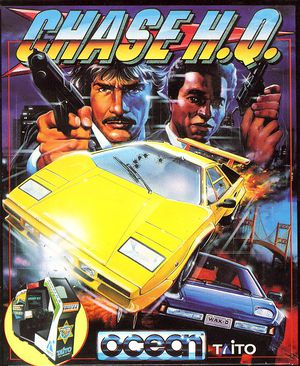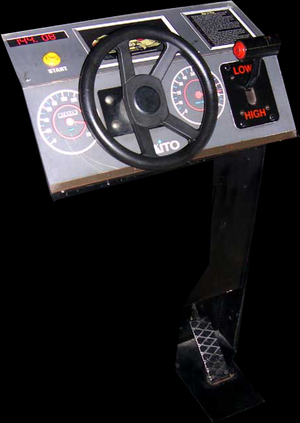Lost In Translation/Chase H.Q.
| Chase H.Q. | |
|---|---|
| Manufacturer | Taito Corporation Japan |
| Released | 1988 |
| Control Method |
2-way Joystick Analog joystick 4 Button(s) |
| Main CPU | (2x) 68000 (@ 12.000 MHz) 68000 (@ 12.000 MHz) |
| Sound CPU | Stereo YM2610 (@ 8.000 MHz) |
| Video Details |
Raster (Horizontal) 320 x 240 pixels 60.00 Hz 4,096 Palette colours |
| Screens | 1 |
| ROM Info | 53 ROMs 8,734,868 bytes (8.33 MiB) |
| MAME ID | chasehq · chasehqj |
About The Game
Chase H.Q. is a chase-view, driving arcade video game where the player takes on the role off an undercover cop and gets behind the wheel of a custom Porsche in this Miami Vice-inspired racer from Taito. The player has 60 seconds to catch up to the criminal and then a further 60 seconds to ram his car until it is too damaged to drive.
Like Sega's seminal "Out Run", Chase H.Q. features forked junctions offering players a choice of routes; in this game, however, the route selected is merely a temporary diversion and dictates how quickly the criminal is caught up with. The player's Porsche is equipped with a limited number of turbo boosts which, when used, push the car to incredible speeds - at the expense of control. The turbos must be used wisely if the player is to have a chance of capturing the criminal before the time limit expires.
Chase H.Q. was arguably the first sprite-scaled racer since Sega's legendary "Out Run" - released 2 years' earlier - to truly capture the gaming public's imagination. The game consists of 5 levels.
Trivia
Released in November 1988.
The names main characters of chase H.Q. are as follows...
- The Caucasian cop : Tony Gibson
- The African-American cop (A.K.A. Mr. Driver) : Raymond Broady
- Chase H.Q.'s Dispatcher : Nancy (she doesn't have a last name)
The main player's car (the black Porsche) makes an appearance in the spin-off to the Chase H.Q. series : "Crime City".
Pony Canyon / Scitron released a limited-edition soundtrack album for this game (Syvalion : G.S.M. Taito 3 - D28B0014) on 21/03/1989.
Series
- Chase H.Q. (1988)
- S.C.I. - Special Criminal Investigation (1989)
- Super Chase - Criminal Termination (1992)
- Ray Tracers (1997, Sony PlayStation)
- Chase H.Q. 2 (2007)
Staff
- Game Designer
- Hiroguki Sakou
- Game Programmers
- Takeshi Ishizashi
- Takeshi murata
- Kyoji Shimamoto
- P.C.B Designer
- Masahiro Yamaguchi
- Sound Designers
- Yoshio Imamura
- Naoto Yagishita
- Eikichi Takahashi
- Fumiaki Imaoka
- Music Composer
- Takami Asano
- Cabinet Designer
- Nobuyuki Iwasaki
- Proposer
- Yoshiharu suzuki
Cabinet and Artwork
Ports
- Consoles
- Nintendo Famicom (1989)
- NEC PC-Engine (1989)
- Nintendo Game Boy (1990)
- Sega Master System (1991)
- Sega Game Gear (1991) (Japan version only)
- Sega Saturn (1996, "Chase H.Q. Plus S.C.I.")
- Nintendo Game Boy Color (2000, Chase H.Q.: Secret Police)
- FM Towns Marty
- Sony PlayStation 2 (2007, "Taito Memories II Vol. 2")
- Computers

- Amstrad CPC (1989)
- Commodore Amiga (1989)
- Atari ST (1989)
- Sinclair ZX Spectrum (1990)
- Commodore C64 (1990)
- Sharp X68000 (1992)
- Others
- Mobile Phones (2004)
Soundtrack Releases
| Album Name | Catalogue No. | Released | Publisher | Comments |
|---|---|---|---|---|
| Syvalion -G.S.M. Taito 3- | D28B-0014[1] | 1989-01-11 | Scitron Digital Content Inc. | CD version. |
| Chase H.Q. Overseas Special Version | N/A[2] | 1988-01-01 | Pony Canyon/Scitron | Cassette version. |
| Chase H.Q. / Special Criminal Investigation | TOCT-6113[3] | 1991-04-12 | Toshiba EMI | CD version. |
| Syvalion -G.S.M. Taito 3- | 25P5-0014[4] | 1989-01-11 | Scitron Digital Content Inc. | Cassette version. |
| Taito Chase H.Q. | E20H-1006[5] | 1988-11-21 | Pony Canyon, Scitron | CD-Video version. |
| Beep Special Project - SUPER ARRANGE GAME MUSIC | N/A[6] | 1988-11-01 | Softbank Publishing | Vinyl version. |
External Links
- Sinclair ZX Spectrum version of Chase H.Q. at the World of Spectrum
References
- ↑ Syvalion -G.S.M. Taito 3- (CD) at the VGMdb
- ↑ Chase H.Q. Overseas Special Version (Cassette) at the VGMdb
- ↑ Chase H.Q. / Special Criminal Investigation (CD) at the VGMdb
- ↑ Syvalion -G.S.M. Taito 3- (Cassette) at the VGMdb
- ↑ Taito Chase H.Q. (CD-V) at the VGMdb
- ↑ Beep Special Project - SUPER ARRANGE GAME MUSIC (Vinyl) at the VGMdb









